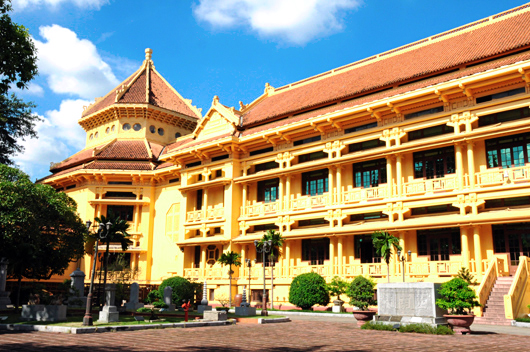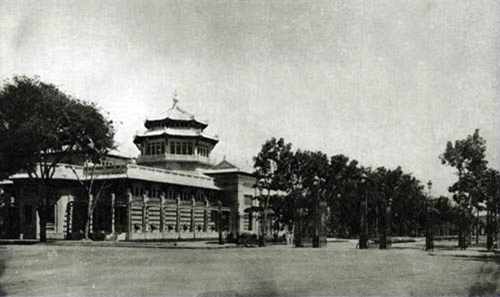
However, conservation work is only one of the many important contributions of the EFEO to the social sciences and humanities in Vietnam throughout the 20th century. To gain a comprehensive view of the EFEO's contributions, let's review some aspects of its formation and activities. On January 20, 1900, the Governor-General of Indochina, Paul Doumer, signed a decree establishing the "French School of Far Eastern Studies" (École francaise d'Extrême-Orient) on the basis of the "Permanent Archaeological Mission in Indochina" established at the end of 1898. More than a year later, on February 26, 1901, the French President Émile Loubet signed a decree officially recognizing the establishment of the EFEO. Accordingly, the Academy became an institution of the French state, a scientific research agency on history, archaeology, linguistics, ethnology, geophysics, and human geography in the East, ensuring the preservation and safeguarding of historical sites in Indochina.

The former Far East Institute of Archaeology, now the National Museum of History.
Over its more than a century-long journey, the EFEO has experienced many ups and downs alongside the vicissitudes of Vietnamese national history. From its founding until the August Revolution (1945), despite being under the control of the colonial government, the EFEO consistently maintained its independent scientific goals, achieving brilliant successes in research, publication, and the preservation of heritage and culture. During the brief period alongside the Democratic Republic of Vietnam (September 1945-December 1946), the flexible policies of the Vietnamese state allowed the EFEO to have administrative autonomy and manage its headquarters. During the approximately 10 years under French rule, coupled with a shortage of research staff (both French and Vietnamese), the EFEO headquarters moved to Saigon after the Geneva Accords (1954) and officially closed in 1960, ending six decades of operation in Vietnam. In 1993, EFEO reopened its representative office in Hanoi. Currently, in addition to its headquarters in Paris, EFEO has 18 centers located in 12 countries, including representative offices in both Hanoi and Ho Chi Minh City, Vietnam.
Having undergone a long and continuous development process spanning over a century, the EFEO has made many important contributions to the formation and development of social sciences and humanities in Vietnam, as demonstrated in the following aspects:
Firstly, the EFEO contributed to preparing the scientific foundations and prerequisites for the formation of several modern social sciences and humanities disciplines in Vietnam, including archaeology, ethnology, textual studies, museology, etc. Prominent scholars of the EFEO made many groundbreaking discoveries, leaving behind many valuable scientific works that are still relevant today, such as: Madeleine Colani, Olov Jansé, Louis Malleret, H. Parmentier, Henri Maspéro, Paul Lévy, Louis Finot, George Coedès, André-Georges Haudricourt, Georges Condiminas,…
Secondly, EFEO contributes to promoting and modernizing traditional social sciences and humanities alongside newly established fields, such as history, Sino-Vietnamese studies, folklore and customs, ancient architecture and sculpture, etc. Many in-depth and systematic research works on Vietnamese history have been researched and published, contributing to expanding understanding and promoting it to the world.

The French School of Far Eastern Studies, a French research center on Indochina in 1926, was located in South Vietnam.
Thirdly, the EFEO contributed to building a team of international Vietnam studies scholars (primarily French scholars), while also facilitating the training of a generation of modern Vietnamese social scientists in the 20th century. The implementation of research programs in Vietnam, especially in the first half of the last century, attracted and built a team of renowned researchers from Louis Finot, George Coedés, Madeliene Colani, Olov Jansé, Louis Malleret, H. Parmentier, Henri Maspéro, Paul Lévy to André-Georges Haudricourt, Georges Condominas, etc. In addition, a golden generation of Vietnamese researchers matured thanks to cooperation and collaboration with EFEO in academic activities, notably: Nguyen Van To, Tran Van Giap, Tran Ham Tan, Nguyen Van Huyen… The academic atmosphere of EFEO directly contributed to the formation of a Westernized and modern education in Vietnam, thereby contributing to the training of outstanding intellectuals of Vietnamese social sciences in the second half of the 20th century, from the pioneering generation such as Tran Van Giau, Dao Duy Anh, Tran Duc Thao, Hoang Xuan Han, to the generation of scholars. Leading scientists trained and matured after peace was restored in the North, such as Dinh Xuan Lam, Phan Huy Le, Tran Quoc Vuong, Ha Van Tan, etc., were generations of intellectuals who gathered, developed, and harmoniously combined the essence of many major contemporary sciences and educational systems, including Chinese studies, French studies, and Russian studies.
Fourth, EFEO has organized numerous large-scale research programs and projects, contributing to illuminating many academic aspects in Vietnam. In the first half of the 20th century, ethnographic fieldwork programs led to comprehensive and profound understandings of ethnic groups and their languages; archaeological explorations and excavations provided further scientific arguments contributing to the discovery and clarification of many issues concerning archaeological eras, kingdoms, and ancient cultures…with thousands of rubbings and inscriptions… In addition, EFEO has also strived to publish a series of works to socialize the research results of French and Vietnamese scientists.
After re-establishing its representative office in Hanoi in 1993, EFEO actively implemented numerous research programs and published many influential works, notably:Kinh Bac Administrative Agency(1996)Vietnamese taboo words through the dynasties(1997)Literature and poetry of the Dong Kinh Nghia Thuc school(1997)L'Univers des Truyện Nôm(1998)Issues in the study of Nguyen Trai's military orders and texts.(1999)Specific names and archival documents about villages in Northern Vietnam.(1999)…In particular, within the framework of the large-scale interdisciplinary research program on Vietnamese villages, the monographVillages in the Red River Delta: an unanswered question.Published in 2002, it brings together leading researchers on Vietnam such as Phan Huy Le, Le Ba Thao, Phan Dai Doan, Dao The Tuan, Dang Nghiem Van, P. Papin, Nelly Krowolski, Oliver Tessier… In recent years, EFEO has invested considerable effort and funding in the research project on the Truong Luu rampart in Quang Ngai and has had some initial publications.
Fifth, EFEO has made practical contributions to the collection and preservation of antiquities and the construction of modern museums, contributing significantly to heritage management in Vietnam. A series of large-scale museums have been built since the beginning of the 20th century: the Louis Finot Museum (1901, now the Vietnam National Museum of History), the Henri Parmentier Museum (1918, now the Cham Sculpture Museum in Da Nang), the Blanchard de la Brosse Museum (1929, now the Ho Chi Minh City Museum of History)... In addition, EFEO has strived to catalog monuments throughout Indochina, publishing numerous heritage catalogs. Many restoration programs for historical sites have also been invested in and implemented (Champa relics in 1901-1903, Temple of Literature - National University in 1918-1920, One Pillar Pagoda in 1922, But Thap Pagoda and Phat Tich Pagoda in Bac Ninh in 1930...).
It can be said that, during its more than a century of presence in Vietnam, despite periods of ups and downs, the French School of Far Eastern Studies (EFEO) has always been a solid bridge connecting Vietnamese academia with the world, especially with French and European academia. Through its scientific activities, the EFEO has made many practical contributions to introducing new research trends, new scientific viewpoints and schools of thought, and modern interdisciplinary approaches, thereby contributing to the strong development and integration of Vietnamese social sciences and humanities.
Author:Prof. Dr. Nguyen Van Khanh
Newer news
Older news